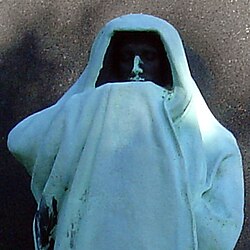Eternal Silence
| Eternal Silence | ||
|---|---|---|
| National Register of Historic Places | ||
| Historic District Contributing Property | ||
|
Who looks into the eyes of the statue, can, according to an urban legend his own death imagined than-life, three-meter-high Art Nouveau - bronze sculpture with hooded coat |
||
|
|
||
| location | Graceland Cemetery , Chicago , Cook County , Illinois | |
| Coordinates | 41 ° 57 '19.3 " N , 87 ° 39' 34.8" W | |
| Built | 1909 | |
| architect | Lorado Taft and Jules Bercham | |
| Architectural style | Art Nouveau ( Jugendstil ) | |
| NRHP number | 00001628 | |
| The NRHP added | January 18, 2001 | |
Eternal Silence (Eternal Rest) is a 1909 by the American sculptor Lorado Taft created bronze sculpture and before black granite blocks. It stands on the Graceland Cemetery in Chicago and is also known as Dexter Graves Monument or Statue of Death (Statue of Death) known.
history
The monument was designed by Lorado Taft and cast by Jules Bercham . Taft engraved his signature on the north side of the base. The south side is with Am. Art Bronze Foundry J. Bercham -Chicago- labeled.
The monument commemorates Dexter Graves (* around 1793; † April 29, 1845), who led a group of 13 settler families from Ohio to Chicago in 1831 . Graves died in 1845, 75 years before the statue was created and 16 years before the cemetery was founded. His body was believed to have been reburied from the initial resting place in City Cemetery in what is now Lincoln Park . The Testament of Graves' son Henry († 1907) contained a budget of 250,000 $ for the monument and saw another $ 40,000 for a memorial to Henry's favorite racehorse Ike Cook ago. According to the will, the horse memorial was to be erected on a drinking fountain for horses in Washington Park, but was never realized, although there was a model for it. Instead, another statue by Taft, Fountain of Time ( en ) , a figure similar to Eternal Silence with a hooded cloak , was erected there in 1920 .
layout
The three meter high bronze sculpture stands on a black granite base in front of a block of granite. The black granite contrasts with the bronze sculpture, which is heavily oxidized today due to its age. The cemetery authorities had previously polished the statue to show the original bronze sheen before several complaints expressed a desire to show it back in its green patina, which has now been left on the sculpture.
The Art Nouveau style depiction is based on traditional depictions of the grim reaper in the hooded cloak and was influenced by Taft's own ideas about death and eternal rest. Historically, the sculpture shows similarities with the sculpture of a funeral procession at the tomb of Philip II the Bold in Dijon and the Adams Memorial of Augustus Saint-Gaudens in Washington, DC The statue is considered famous and has been called the "most unforgettable" monument in Graceland Cemetery . Ada Bartlett Taft's book Lorado Taft; Sculptor and Citizen from 1946 lists Eternal Silence as one of the artist's most significant works. Images from Eternal Silence were used in other works of art, including by Claes Oldenburg .
Eternal Silence is described as eerie (“eerie”), gloomy (“somber”), grim (“grim-looking”), shrouded in mystery (“mysterious”) and spooky (“haunting”). According to a metropolitan legend , viewing the statue's eyes can trigger a hallucinatory vision of death .
literature
- Charles D. Kiefer, Rolf Achilles, and Neil A. Vogel: Graceland Cemetery ( pdf ), National Register of Historic Places Registration Form, Haargis Database, Illinois Historic Preservation Agency, June 18, 2000, accessed October 8, 2011.
Web links
Individual evidence
- ↑ a b c Ursula Bielski: Creepy Chicago: A Ghosthunter's Tale of the City's Scariest Sites , ( Google Books link ), Lake Claremont Press, 2003, p. 93, ISBN 1-893121-15-1 .
- ↑ " Graceland Cemetery, Graves Monument ( Memento of the original from September 11, 2009 in the Internet Archive ) Info: The archive link was automatically inserted and has not yet been checked. Please check the original and archive link according to the instructions and then remove this notice. ", Property Information Report, Haargis Database, Illinois Historic Preservation Agency, accessed October 8, 2011.
- ↑ Kiefer et al., P. 132.
- ↑ a b c d e f Kiefer et al., Pp. 68-69.
- ^ Graceland Cemetery: Map of historical resting places - Dexter Graves.
- ↑ Barbara Lanctot: A Walk Through Graceland Cemetery: A Chicago Architecture Foundation Walking Tour , A Chicago Architecture Foundation Walking Tour, Chicago, Illinois, 1992, p. 6.
- ↑ a b c The Strange History of "Eternal Silence," Graceland's "Statue of Death" - Mysterious Chicago Tours . Retrieved February 6, 2019.
- ↑ a b c d e Kiefer et al .: pp. 146–47.
- ↑ a b Scottie Cohn: Chicago Curiosities: Quirky Characters, Roadside Oddities & Other Offbeat Stuff , ( Google Books link ), Globe Pequot, 2011, pp. 86-87, ISBN 0-7627-5984-4 .
- ↑ Irving Cutler: Chicago: Metropolis of the Mid-Continent , ( Google Books link ), SIU Press, 2006, p. 285, ISBN 0-8093-2702-3 .
- ↑ a b Alice Sinkevitch: AIA Guide to Chicago , ( Google Books link ), Houghton Mifflin Harcourt , 2004, p. 227, ISBN 0-15-602908-1 .


